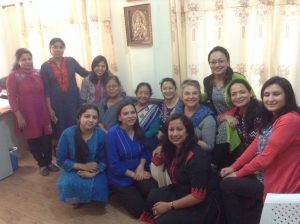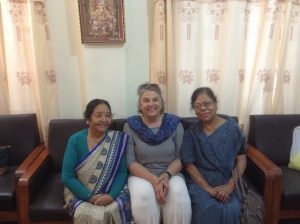Nepal had called me back again. My last visit there was 20 years ago, so I was very curious about the changes that had occurred, especially after the 2015 earthquake. I spent time in the capital city of Kathmandu, the surrounding small towns as well as a mountaintop monastery. These are my reflections about some (planned and unplanned) nursing experiences; my acute awareness of public health wherever I go, and some thoughts about the experience of traveling alone.
Through the generous help of Sumitra Sharma, a nursing lecturer at Kathmandu Medical College, whom I met through the Global Nursing Caucus, I spent a day conducting a lecture for the second and third year BSN nursing students and meeting the nursing faculty at the college. But before getting to the college, so much happened. The morning started with someone at my guesthouse finding me and asking for help. A young boy had been bitten by a dog, while on his way to school. It was a nasty bite and while a few of us helped him by cleaning and dressing his arm, the folks at the local cafe gave him some toast and tea. His mother was called and she took him to the government hospital for treatment (stitches and rabies shots), as it is free for these types of problems. There are many dogs around, running in packs and are particularly dangerous for young children. This is just one of the challenges that some Kathmandu residents face in their daily lives.
This event illustrated things that have and have not changed over the past 20 years. I have vivid memories from previous trips of the packs of dogs barking all night and having to be careful while walking in the lanes. Now there is a clinic close by, but the family could not afford their care, and so went to the government hospital. This boy was lucky to be going to school, as it is not a given for all children in Nepal. Despite a statistic of 96.2 % for boys attending primary school (https://www.unicef.org/infobycountry/nepal_nepal_statistics.html), I met children who were illiterate. After this rather unusual start to the morning, I was picked up by the driver from the college and we entered the chaos of Kathmandu traffic. What should have taken us 20 minutes, took an hour and a half. The traffic here is epic. The roads are being redone, due to laying water pipe (which is a good thing from a public health standpoint) and most are extremely dusty and have very large ruts and potholes. Everyone wears masks while on the streets.
There has been a major increase in the population of the Kathmandu Valley over the past 15 years (from 644,000 in 2000 to 1.26 million in 2017). (http://worldpopulationreview.com/world-cities/kathmandu-population/) As well, there is a construction boom due to the population increase and rebuilding after the 2015 earthquake (https://www.britannica.com/topic/Nepal-earthquake-of-2015) which impacts so much of daily life. Another factor is that over the last years, there has been a significant increase in (many) people’s income, much of it from remittances (31.75% of Nepal’s GDP), and one result is there are many more vehicles on the roads.
We eventually arrived at the school. I gave a talk about global health and ethics. The students took a little while to warm up, but then engaged, especially when they shared what they had learned from their personal experience during the earthquake. Many spent days and weeks sleeping outside of their homes. They also asked very pertinent questions the experience of nursing students and nurses in America.
After the lecture, Sumitra had organized a lovely meet and greet with the nursing faculty. We talked about global nursing, about the aftermath of the earthquake and it’s impact on the school (they had to move to a difference building), and about nursing education. I found it fascinating to speak with the senior faculty about their educational trajectory. One told me that she had gotten her original nursing degree in Nepal, went on to do her BSN and MSN in India in clinical nursing, and has been teaching for the past 9 years. She then proudly waved to the whole nursing faculty and said that they all had gotten their Master’s degrees in Nepal.
This story in Nepal reminded me of our keynote presenter at the most recent GNC conference. She had such a significant impact on nursing in Malawi and had gone to South Africa for her degrees. Both these stories illustrate the fundamental importance of connections among global nurses both in education and practice. It also brought to mind the Regis-Haiti project, and how hard people (folks at Regis College, at the University of Haiti and the Ministry of Health) have worked to bring further education in nursing there. Meeting these women is so inspiring. They have laid the groundwork to advance nursing and improve the provision of health care in their countries. Their stories show not only how important it is for all of us to appreciate access to higher education, but also the significance of a global nursing support system and networking, hence the role of GNC in this space.
During the faculty discussion, we spoke about the importance of communicating the understanding and innovation that has been fostered here to any resource poor settings. I was reminded how much the US has to learn from what is being created in Nepal and other countries. It was very heartening to meet everyone and share our nursing experiences and interests. We also talked about sharing information and possibly collaborating on a conference in the future. There was a sense of potential and an excitement at the thought advancing the global nursing community in this way.
During this entire journey, I was struck by the kindness and interest of the many people who I encountered while traveling- particularly when traveling alone, when one is vulnerable and dependent on the proverbial “kindness of strangers”. This vulnerability and dependence is something that is usually avoided, and is not necessarily comfortable. But it opens one up to
meeting people, giving space for their compassion, and the possibility of making connections that can be extraordinary. It also calls out the best in others and one’s self. Many times this kindness is not transactional (give and take) but purely allowing others to give and then graciously receiving. Then you give to someone else in the future, and they pass it forward. So many people
were gracious, showing such generosity to me in many ways: from the faculty of the nursing school to nuns at a mountaintop monastery. This is a subject for contemplation wherever we find ourselves, at home or abroad; particularly now, with the prevailing narrative of fear and negativity that has permeated the media and airwaves. It is so striking that we are one world
community, whether the commonality is nursing, education, wanting to help a child or sharing the awareness of our inherent humanity.

